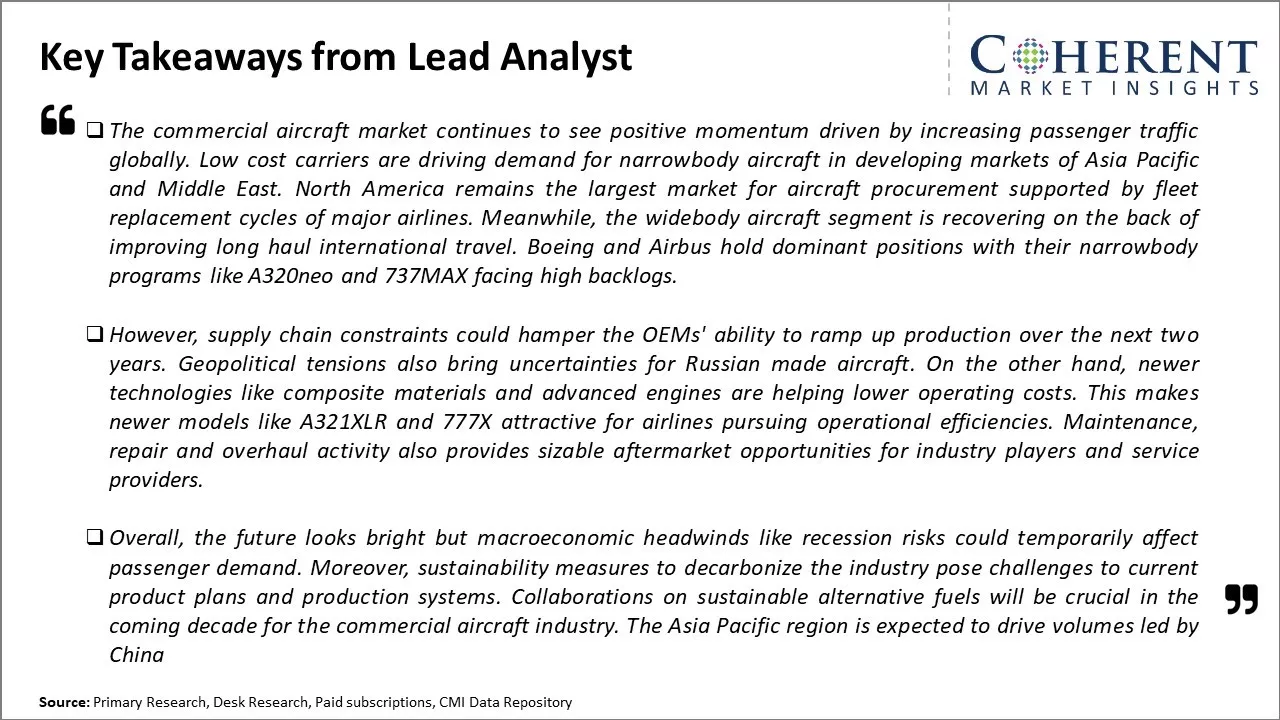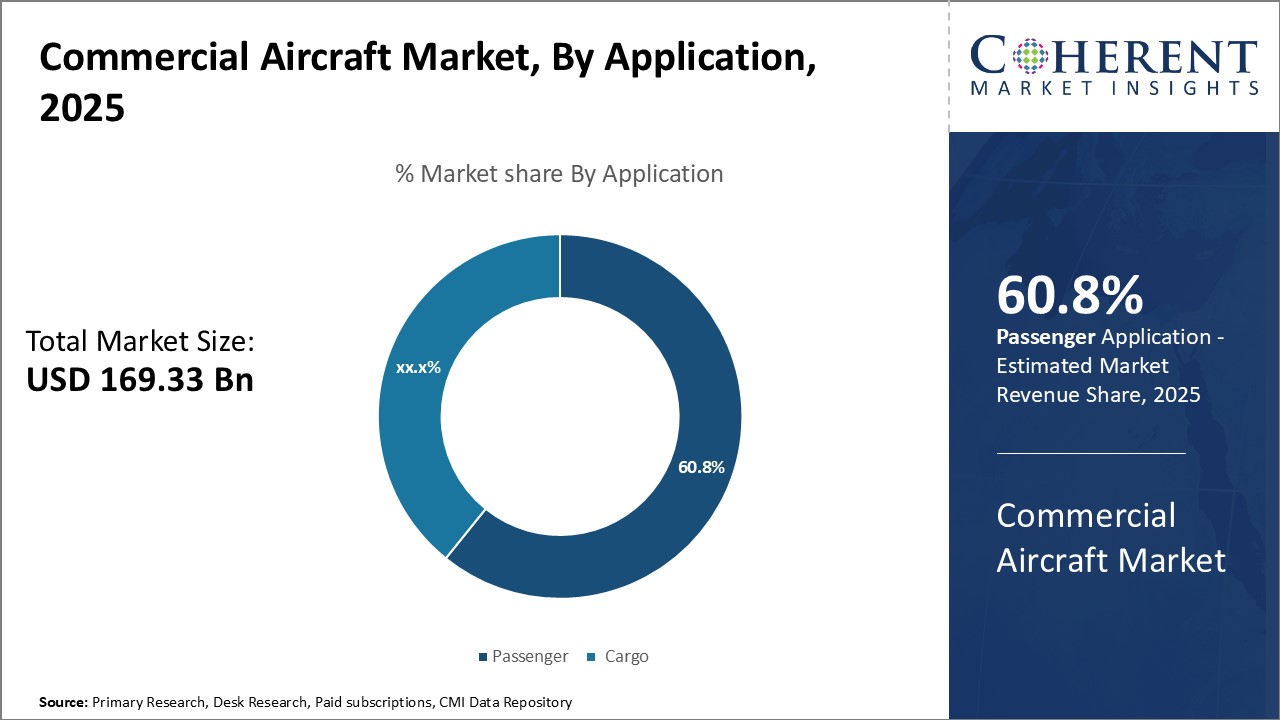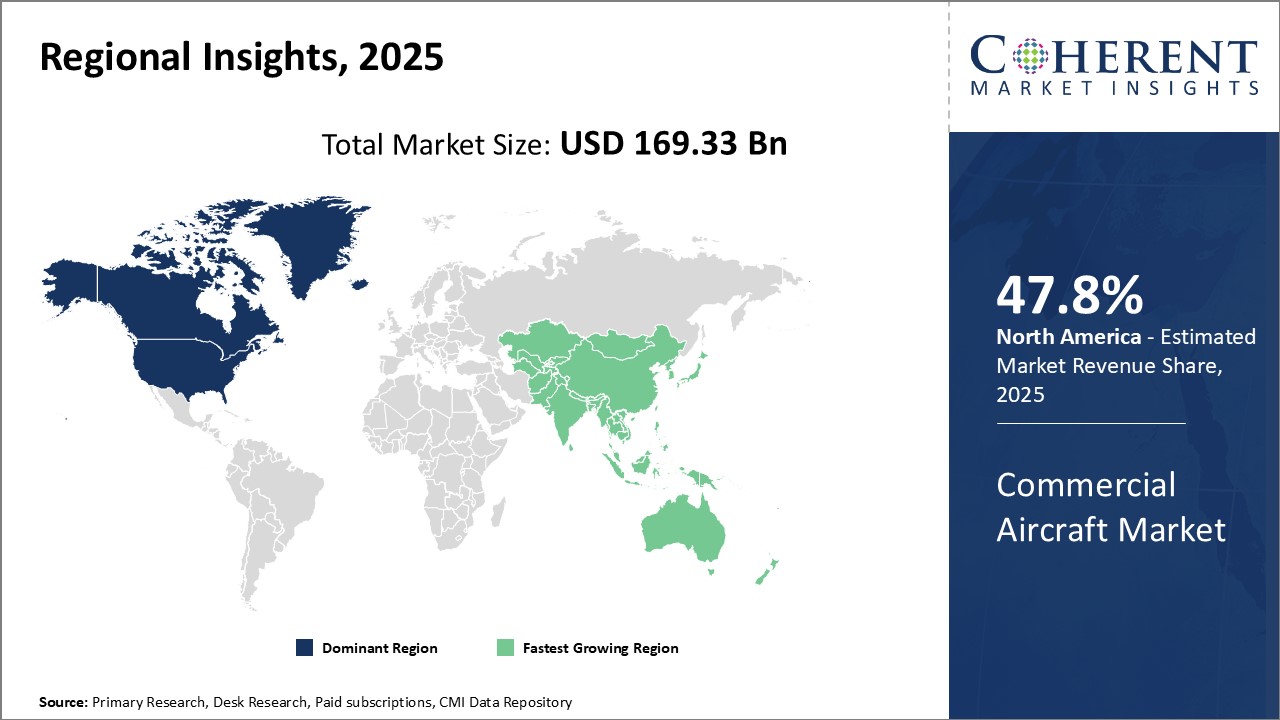The commercial aircraft market is estimated to be valued at US$ 169.33 Bn in 2025 and is expected to reach US$ 265.04 Bn by 2032, growing at a compound annual growth rate (CAGR) of 6.6% from 2025 to 2032.

Discover market dynamics shaping the industry: Request sample copy
The commercial aircraft market is witnessing positive trends with increasing passenger air traffic globally. Low cost carriers are driving the demand for narrowbody aircraft while oils continue to see strong orders from established airlines. While COVID-19 impacted commercial aviation, vaccination programs and renewed economic activities have fueled optimism among aircraft manufacturers and airlines. Orders for new fuel efficient aircraft models and expansion of fleets suggest that the long term outlook remains robust. However, supply chain challenges, geopolitical issues, and rising costs could impact the market growth in the near term.
Growing international trade and tourism
The international trade and tourism industry has experienced robust growth due to increasingly globalized supply chains and lower trade barriers. This has driven significant demand for passenger and cargo air travel between countries. Major economies with well-developed transportation infrastructure have become hubs for the movement of goods and people across borders. The expansion of middle-classes in emerging markets has also boosted discretionary spending on international leisure travel and business trips abroad. Carriers require new aircraft to meet this rising cross-border traffic and freight volumes. Additionally, low-cost carriers have emerged as an affordable option for locally-based flyers to travel within and between regions. This has expanded the overall commercial aviation customer base. Overall higher incomes and greater desire to explore other cultures have played a role in air travel becoming an integral part of the global trade and tourism ecosystem, helping drive the demand for widebody and narrowbody aircraft.

Get actionable strategies to beat competition: Request sample copy
Fleet replacement and modernization programsAs commercial aircraft fleets age, airlines are increasingly undertaking fleet replacement and modernization programs to reduce maintenance and fuel costs through the adoption of new-generation fuel-efficient planes. While some carriers extend the operational lives of older planes through refurbishment and component replacements, most full-service network carriers prefer replacing their oldest and least economical jets with new aircraft featuring state-of-the-art engines and aerodynamic designs. This allows substantial reductions in operating expenses through lower maintenance and fuel burn. Additionally, newer aircraft meet enhanced safety and emission regulations while providing enhanced passenger comfort and services. Low-cost carriers too are standardizing their operations around specific modern aircraft types to benefit from common pilot/crew training, inventories, and maintenance practices. Global aircraft fleet age profiles indicate a large number of aircraft built in the 1990s and early 2000s will need replacement in the coming decade. This is driving requirements for new narrowbody and widebody deliveries to support fleet revamp programs across Asia Pacific, North America, Europe, and other regions.

To learn more about this report, Request sample copy
Market Challenges: Air travel demand has slowed due to economic uncertainties caused by trade wars and fears of recessionAir travel demand has slowed due to economic uncertainties caused by trade wars and fears of recession. Aviation companies are also dealing with the grounding of Boeing's 737 MAX aircraft due to safety concerns, which has disrupted supply chains. Additionally, geopolitical tensions have increased risks for airlines operating in conflict zones. Environmental regulations are tighter with a push for more fuel-efficient planes, driving up costs of development and manufacturing.
Market Opportunities: Rising demand of air travel
Long-term prospects remain bright as passenger traffic is projected to double over the next 20 years. As more people begin to travel by air, especially in developing economies, the demand for new aircraft will continue. The demand for low-cost carriers is growing and requires new fuel-efficient planes. Technological advancements in automation, electric, and hybrid-electric aircraft may lower operating costs and emissions to boost opportunities.

Discover high revenue pocket segments and roadmap to it: Request sample copy
Insights By, Application- Passenger Travel Dominates the Growing Demand for Air TransportThe passenger travel segment accounts for the vast majority owing 60.8% in 2025 of commercial aircraft utilization globally. This is due to the long term growth in the demand for air transportation of people worldwide, especially on domestic and international routes connecting major cities and countries.
Rising standards of living in emerging markets have lifted hundreds of millions out of poverty, increasing their ability to afford air travel for the first time. Meanwhile, low cost carriers have made flying accessible even to budget travelers in developed nations through unbundled fares and secondary airports. Liberalization policies have also spurred competition and new entrant airlines promoting heavily discounted tickets.
Businesses too have come to rely on airplanes for efficiently moving their employees, customers, and supply chain partners around large territories. International tourism has boomed as passport holding continues to spread, attracting record numbers eager to experience other cultures through air vacation packages. Online travel agencies now make flight and hotel bookings easier than ever before.
As this global air passenger market matures and gains new participants, aircraft manufacturers are focusing on designing planes optimized especially for consumer comforts on longer routes. While cargo traffic maintains important, it is the everyday movement of people that truly drives demand and the future outlook for the commercial jet industry remains closely tied to projecting population growth, income levels, and societal mobility trends.
Insights By, Size- Narrow Body Dominates the Size Segment Due to Cost Effectiveness and Flexibility
The narrow body aircraft segment accounts for the largest share owing 60.8% in 2025 of the commercial aircraft market by size. This is primarily due to narrow bodies being the most cost effective option for airlines operating short and medium haul routes. Narrow body aircraft like the Boeing 737 and Airbus A320 families can fly routes of up to 5,000 kilometers with higher passenger capacity than regional jets but at lower operating costs than wider aircraft.
This cost effectiveness comes from narrow bodies having a smaller fuselage size that requires less fuel and maintenance costs per flight. Their single aisle configuration also allows for faster turnaround times at airports. Moreover, spare parts and pilot training costs are lower due to the large fleets of narrow bodies in operation worldwide. Several airlines have entirely replaced older fleets with new fuel efficient narrow bodies to reduce trip expenses.
Narrow bodies are also very flexible for airlines to deploy on their route networks. With higher passenger volumes than regional jets but lower costs than wide bodies, they can profitably serve a wide range of shorter domestic and regional international routes. Airlines can easily add or remove narrow body flights to quickly adapt schedules according to demand fluctuations. This has kept narrow bodies first choice for the densest traffic flows within regions like Europe, Asia Pacific, and North America.
Newer narrow body models from Boeing and Airbus now have similar maximum ranges as older wide bodies while burning 15-20% less fuel. This has allowed even some longer thinner routes to now be flown economically by narrow bodies instead of larger aircraft. Further technological improvements are set to solidify narrow bodies' dominance of the short and medium haul market segments for the foreseeable future.

Need a Different Region or Segment? Customize now
North America has dominated the commercial aircraft market for decades owing 47.8% in 2025 to a strong presence of major Original Equipment Manufacturers (OEMs) like Boeing and key industry participants across the value chain. The U.S. is home to the largest aircraft manufacturers, suppliers as well as airlines which has created a robust ecosystem driving the regional market growth. Majority of commercial aircraft orders are fulfilled by American companies which cater to both domestic as well as international carriers. This has established the region as manufacturing and technological hub for commercial aviation. The supply chain is highly integrated with components and engineering expertise available locally. Several aircraft assembly lines and manufacturing facilities are located across different states which ensures smooth production and delivery.
Asia Pacific has emerged as the fastest growing regional market for commercial aircraft in recent years. China especially has witnessed exponential air passenger traffic on the back of expanding economy, rising incomes, and growing international trade. This has fuelled the demand for new aircraft from Chinese as well as other Asian airlines. In order to capture this huge market opportunity, global OEMs have started setting up manufacturing plants and engineering centers to cater to the regional requirements. Original equipment manufacturers have also partnered with local component manufacturers to leverage low cost manufacturing and integrate them in global supply chain. This is significantly boosting production rates and lowering overall costs. Meanwhile, other Southeast Asian countries with major aircraft lessors and carriers like Singapore, Malaysia, and Indonesia are also emerging markets driving the overall regional commercial aviation growth.
The North America region continues to enjoy strong order pipeline from its airlines coupled with support from the government which is positively impacting the commercial aircraft industry. On the other hand, the Asia Pacific region is poised to surpass North America in the coming decade led by market expansion in China and other developing economies. Rapid infrastructure development and urbanization makes this region attractive for long term business prospects.
Commercial Aircraft Market Report Coverage
| Report Coverage | Details | ||
|---|---|---|---|
| Base Year: | 2024 | Market Size in 2025: | USD 169.33 Bn |
| Historical Data for: | 2020 To 2024 | Forecast Period: | 2025 To 2032 |
| Forecast Period 2025 to 2032 CAGR: | 6.6% | 2032 Value Projection: | USD 265.04 Bn |
| Geographies covered: |
|
||
| Segments covered: |
|
||
| Companies covered: |
Boeing Company , Airbus SE , Embraer S.A. , Bombardier Inc. , Lockheed Martin Corporation , General Dynamics Corporation , United Technologies Corporation , Rolls-Royce Holdings plc , Honeywell International Inc. , Safran SA , Thales Group , and Raytheon Technology |
||
| Growth Drivers: |
|
||
| Restraints & Challenges: |
|
||
Uncover macros and micros vetted on 75+ parameters: Get instant access to report
*Definition: The commercial aircraft market consists of the designing, developing, manufacturing, selling, and leasing of large airplanes for transporting passengers and cargo by airlines and cargo carriers. Major manufacturers in this market produce a variety of commercial aircraft ranging from narrow-body jets used for short and medium-haul flights to wide-body jets used for long-haul international routes to turboprop airliners used for regional routes. Key players compete based on aircraft performance, passenger experience, operating costs, and environmental friendliness.
Share
Share
About Author
Gautam Mahajan is a Research Consultant with 5+ years of experience in market research and consulting. He excels in analyzing market engineering, market trends, competitive landscapes, and technological developments. He specializes in both primary and secondary research, as well as strategic consulting across diverse sectors.
Missing comfort of reading report in your local language? Find your preferred language :
Transform your Strategy with Exclusive Trending Reports :
Frequently Asked Questions
Joining thousands of companies around the world committed to making the Excellent Business Solutions.
View All Our Clients
US Reciprocal Tax Impact Analysis On Commercial Aircraft Market
Stay updated on tariff changes with expert insights and timely information